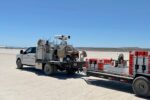Australia is accelerating its undersea warfare capabilities with the upcoming deployment of the “Ghost Shark” — a stealthy extra-large autonomous undersea vehicle (XL-AUV) designed for long-range strike and ISR missions. Developed under an ambitious three-year co-development program involving the Defence Science and Technology Group (DSTG), the Royal Australian Navy (RAN), and U.S. defense tech firm Anduril Industries, the Ghost Shark is slated for operational deployment by mid-2025.
Ghost Shark Program Overview
The Ghost Shark program was launched in 2022 as part of Australia’s push to rapidly field disruptive naval technologies amid rising strategic competition in the Indo-Pacific. The program aims to deliver three prototype XL-AUVs within a three-year window — an unusually aggressive timeline for such complex underwater systems.
Anduril Industries was selected as the prime industry partner through a competitive process led by DSTG and RAN’s Advanced Strategic Capabilities Accelerator (ASCA). The company brings experience from its work on similar platforms like Dive-LD and its involvement in the U.S. Navy’s Orca XLUUV program.
The Ghost Shark is designed to operate autonomously for extended durations at significant depths while carrying modular payloads tailored for strike, ISR (intelligence, surveillance, reconnaissance), electronic warfare (EW), or mine countermeasures. While exact specifications remain classified, open-source imagery suggests a torpedo-shaped hull approximately 10–12 meters long with multiple payload bays.
Design Philosophy and Technical Features
The Ghost Shark embodies several key design principles:
- Modular Payload Architecture: Enables rapid reconfiguration for different mission profiles — from kinetic strike to ISR or EW roles.
- Autonomous Navigation & AI: Uses onboard artificial intelligence for real-time decision-making in denied environments without GPS or human intervention.
- Stealth & Endurance: Designed with low acoustic signatures and optimized hydrodynamics to allow weeks-long submerged operations at strategic distances.
- COTS + Indigenous Integration: Combines commercial off-the-shelf components with sovereign Australian technologies where feasible.
The vehicle likely uses lithium-ion battery banks or hybrid power systems similar to those used in Boeing’s Orca XLUUV. Communications are expected to be limited during missions due to underwater constraints but may include acoustic modems or surfacing intervals for satellite uplinks.
Operational Implications for RAN
The introduction of XL-AUVs like Ghost Shark represents a paradigm shift in how navies conduct undersea operations. Unlike traditional crewed submarines that require large crews and extensive logistics support, autonomous platforms offer persistent presence at lower cost and risk.
The RAN envisions using these vehicles for:
- Saturation ISR: Persistent surveillance of chokepoints like the Sunda Strait or South China Sea approaches.
- Strike Missions: Delivery of torpedoes or loitering munitions against high-value maritime targets without risking human crews.
- MCM & ASW Support: Supporting mine countermeasures or acting as decoys/sensors in anti-submarine warfare networks.
This aligns closely with Australia’s broader modernization efforts under AUKUS Pillar II initiatives focused on advanced capabilities such as AI-enabled autonomy and quantum sensing. It also complements longer-term plans for nuclear-powered submarines under AUKUS Pillar I by providing near-term asymmetric options against peer adversaries like China’s PLA Navy.
Aggressive Prototyping Timeline and Milestones
The speed of development has been notable. The first “Ghost Shark Alpha” prototype was unveiled publicly in May 2023 — less than one year into development — at Anduril’s facility near Sydney. According to statements from Defence Minister Richard Marles and Chief Defence Scientist Dr. Tanya Monro, two additional prototypes are on track for delivery before mid-2025 when initial operational capability (IOC) is expected.
This rapid pace reflects DSTG’s new approach under ASCA: co-developing critical systems directly with industry through spiral prototyping rather than traditional procurement cycles. The model mirrors successful U.S. programs like DIU’s Rapid Acquisition Office or SOCOM’s Tactical Exploitation programs that emphasize speed over bureaucratic perfectionism.
AUKUS Synergies and Strategic Context
The Ghost Shark effort dovetails with broader trilateral cooperation between Australia, the United States, and the United Kingdom under AUKUS Pillar II — which focuses on emerging technologies including autonomy, cyber capabilities, quantum sensing, hypersonics, and AI integration into command-and-control structures.
AUKUS partners are reportedly exploring interoperability between unmanned platforms across domains — including potential data fusion between Australia’s Ghost Sharks and U.S./UK unmanned surface vessels (e.g., Sea Hunter) or airborne ISR assets via secure networks like Link-22 or SATCOM relays using MUOS-compatible terminals.
This could enable distributed maritime operations where unmanned platforms cue each other across vast oceanic distances without human-in-the-loop latency — a key advantage against near-peer adversaries deploying anti-access/area denial (A2/AD) strategies across contested littorals such as Taiwan Strait or South China Sea corridors.
Challenges Ahead
Despite promising progress, several challenges remain before full operationalization:
- C4ISR Integration: Ensuring seamless data flow between autonomous vehicles and manned command centers remains technically complex due to underwater comms limits.
- MCM/Strike Certification: Validating safety protocols around weaponized payloads on fully autonomous platforms will require careful doctrinal evolution within RAN rules of engagement frameworks.
- Sustainment & MRO Models: Long-duration deployments demand robust maintenance pipelines that do not yet exist at scale within Australia’s naval logistics infrastructure for unmanned systems.
Outlook
If successfully deployed by mid-2025 as planned, Ghost Shark will place Australia among a very small group of nations fielding operationally relevant XL-AUVs capable of strategic-level effects. It will also serve as a testbed for future collaborative autonomy concepts across AUKUS navies while adding depth to Canberra’s deterrence posture amid intensifying maritime competition in Asia-Pacific waters.









